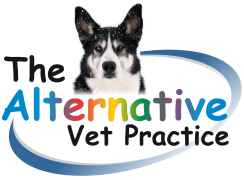Dog Behaviour Therapy & Training
- Dog Behaviour
- Calming Signals
- What is a behaviour problem?
- What will happen during a behaviour / training consultation or workshop?
- My promise... and what I expect from you...
Dog Behaviour
Dogs in their own animal world and environment do not have behavioural problems.Like people, dogs would naturally live in packs which form their families.
To live in harmony, dogs communicate with each other via a very well developed and precise body language which is like our verbal language used on a daily basis in all kinds of situations such as searching for food, searching for shelter, mating, defending off threats and general living together in harmony.
To have the ability and the social skills to avoid conflicts is especially important.
Calming Signals
As described in the book 'On Talking Terms with dogs: Calming Signals' by Turid Rugaas (2005), dogs are conflict-solving animals who use a specific body language to avoid conflicts and to keep peace. These signals are called 'Calming Signals'.
Similar signals, called 'cut-off signals', were described previously by wolf researchers as a means of cutting off aggression between wolves.
These calming signals are used at an early stage to calm down nervousness and fear and to avoid threats from people and dogs. The signals can be used by dogs for calming themselves as well as for indicating goodwill and harmony to other dogs and people.
We to show goodwill to our dogs and to help easing a difficult situation can also use these signals.
There are at least about 30 different calming signals; below are a few examples of some of the most commonly used calming signals described of which some are used for other things as well, in other situations:
Head Turning
 This can be a swift movement with the dog turning his head to the side and back or he can hold the head to the side for some time
This can be a swift movement with the dog turning his head to the side and back or he can hold the head to the side for some time
This signal is often seen when two dogs meet and can also easily be used by people.
Softening the eyes/blinking
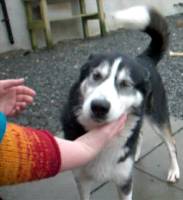 This is often used by dogs when they want to look at someone straight on but want to indicate their peaceful intentions at the same time.
This is often used by dogs when they want to look at someone straight on but want to indicate their peaceful intentions at the same time.
This signal can also easily be used by people.
Turning away
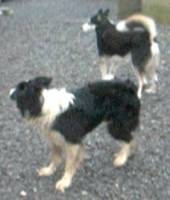 This can be a dog turning his side or his back to someone. This signal is often seen when one dog behaves threateningly towards another dog in some way such as playing too wildly and running up too quickly. You can also see a dog turning away when spoken to in a very cross voice.
This can be a dog turning his side or his back to someone. This signal is often seen when one dog behaves threateningly towards another dog in some way such as playing too wildly and running up too quickly. You can also see a dog turning away when spoken to in a very cross voice.
This signal can easily be used by people when a dog shows signs of nervousness or aggression or is jumping up.
Licking the nose
 This is often a very quick movement of the tongue, flicking so quickly that it might need some experience to see it.
This is often a very quick movement of the tongue, flicking so quickly that it might need some experience to see it.
It is a very common signal that is used in a wide variety of situations such as approaching another dog, bending over a dog; it is also seen very often in combination with other calming signals such as turning the head.
This signal cannot really be used by people.
Sitting down
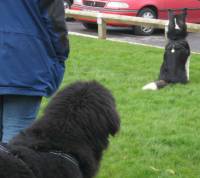 Sitting down either with turning their backs or without is used by dogs when they are feeling uncertain with a situation.
Sitting down either with turning their backs or without is used by dogs when they are feeling uncertain with a situation.
This can easily be used by people by sitting down on a chair e.g. if the dog is unsure about strangers in the house.
Lying down
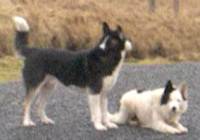 This signal has the same meaning as sitting down but is a much stronger signal. It can be seen very often by an older or high-ranking dog towards a younger or lower-ranking dog who is unsure about the other one.
This signal has the same meaning as sitting down but is a much stronger signal. It can be seen very often by an older or high-ranking dog towards a younger or lower-ranking dog who is unsure about the other one.
This can also easily be used by people, especially in an inside situation just by lying down on the sofa or the floor.
Yawning
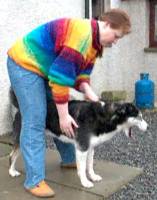 This is seen whenever you dog feels a little scared, stressed or worried in situation such as bending over the dog, going into the vet's, waiting for the owner to get ready for a walk.
This is seen whenever you dog feels a little scared, stressed or worried in situation such as bending over the dog, going into the vet's, waiting for the owner to get ready for a walk.
While maybe looking a little awkward, this can also easily be copied by people in all kinds of situations.
Curving
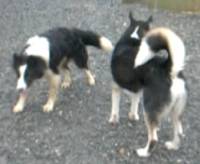 Dogs usually approach each other in a curve to show their peaceful intention. Unless showing other stronger signals, walking straight towards each other is very impolite in the dogs world.
Dogs usually approach each other in a curve to show their peaceful intention. Unless showing other stronger signals, walking straight towards each other is very impolite in the dogs world.
This curve can vary between just curving slightly or using a very wide curve.
When having to pass another dog, you will regularly see your dog breaking out of a heel position and trying to walk on the other side of you. This signal can easily be used by people by curving when approaching a fearful or aggressive dog.
Watch out for these signals and you will be amazed how often your dog or dogs you meet on walks are using them!
It is so important to understand and to allow the body language of our dogs as calming signals are the dogs natural first reaction to a situation which makes the dog feeling uncomfortable or threatened.
The dog will try to 'tell' us something with the use of body language and calming signals. If we or other dogs are not recognising these signals, this might result in frustration and distress and in – in peoples eyes - inappropriate reactions such as not following commands or aggression.
What is a behaviour problem?
A problem is only a problem if you and/or your dog experience it as one. Some behaviours might be fully aceptable for some while totally unacceptable for others. Some behaviours, such as chasing or hunting, can be entirely natural for dogs but not acceptable by society. This acceptance or non-acceptance by society can put an extra stressor on owner and dog as we all feel that our dogs have to behave and we have to react in certain ways to fit in.
Thrown into our human world, dogs try their hardest, and do amazingly well, to understand us – and yet, most of us have no idea what our dogs are trying to tell us.
Constantly trying to communicate but not being understood, is very frustrating for our dogs and will lead to increased stress, fear and aggression levels which then will result in display of inappropriate behaviour, bad habits or behaviour problems.
This is not just a problem with dogs and their owners or other people they come in contact with, but also with dogs trying to communicate with other dogs. Due to their communication skills being suppressed but also due to an extreme diversity in morphological characters in our huge variety of man-made breeds (i.e. the forehead is always wrinkled in several brachycephalic breeds or the eyes cannot be seen at all due to the haircut of the dog), many dogs are not able to communicate precisely anymore.
Miscommunication and misunderstandings have to be called the main reason for the development of behavioural problems. But there are many more of which a few are listed below:
- Communication issues between dog and human or dog and dog
- Misunderstandings
- Lack of socialisation
- Withdrawal of basic needs (i.e. no adequate provision of food, water, rest, exercise, toileting opportunities, contact to people and other dogs)
- Illhealth, e.g.
- metabolic problems (e.g. malfunction of the thyroid)
- loss of senses (e.g. blindness, deafness)
- degenerative diseases (e.g. arthritis, hip dysplasia, spondylosis) causing temporary or chronic pain
- Phobias, e.g. to fireworks, thunderstorms etc
- Hyperactivity
- Obsessive-compulsive disorders
- Stress
- Nervousness – easily startled, jumpy
- Restlessness – constantly fidgeting, unable to calm/settle down
- Overreaction – reacts restless, timid or aggressive in situations in which he would normally remain calm and relaxed
- Mounting – mounting of other dogs, humans or objects shown by male as well as female dogs can be sexually motivated but can also be stress-induced
- Exaggerated self-grooming – this can be a sign of and a compensation for stress and can lead to self-inflicted wounds
- Destroying objects / constant chewing on things – shown especially often when dog is left alone in an attempt to cope with serious stress
- Exaggerated noise making – continuous barking/whining/howling shown in situations where the dog is extremely overburdened and stressed
- Over-eating – frantic gulping down of anything available including inedible things such as stones, wood, gloves, toys, socks which can lead to life-threatening intestinal blockages or internal damages
- Compulsive behaviour – e.g. chasing own tail, excessive licking can be an attempt to cope with stress and can be self-rewarding in case of self-inflicted injuries/pain which result in the release of endorphines ('happy hormones')
- Pulling on lead / biting the lead
- Poor concentration/forgetfulness – in times of high stress the brain is not in a position to take information in which leads to very short concentration spans or forgetting of previously mastered exercises
- Passivity – in long-term stress or a very overwhelming situation it can be seen that the dog is much quieter and not communicating as normal, but withdrawing itself from its environment and 'shutting down'
What will happen during a behaviour / training consultation or workshop?
Most cases, simple as well as complex, are about educating the owner rather than training the dog itself. Dogs only react to our actions and try to cope with their environment. If the owner changes the circumstances, taking into account the environment, their own behaviour, the diet of the dog and other possible stressors working on the dog, then the dog and its behaviour will usually follow suit and most behavioural problems diminish.
Any training I offer is aimed to teach life skills rather than purely obedience so the dog is capable of thinking for himself and making good choices even when you are not around rather than just following commands.
While I believe that every dog should have a basic grasp of obedience, for the same reasons that we teach our children obedience, I do not see any good reason for the very strict traditional obedience.
Using heelwork as an example, why does my dog need to be glued to my left knee? Why can't my dog enjoy sniffing and exploring the ground while still remaining on a loose lead and/or reasonably close to me?
And by the way, why can't it be the right knee?
When the situation allows, I want my dog to be able to enjoy his walk.
And when the situation requires, I want my dog to be able to walk just close enough to be safe and ideally on either side of me so that I can keep myself between my dog and e.g. the road.
The training I offer is about seeing things from your dog's point of view and to understand why your dog is reacting in a certain way. Seeing dogs as natural peacekeepers, most behaviour problems are the result of misunderstandings between owner and dog or between dog and dog. My emphasis and passion in dog behaviour therapy & training lies in improving the communication skills of owner and dog and to teach the owner to understand and appreciate their dog. My gentle approach to dogs is aiming to see every dog as an individual, to look at the root cause of behaviour problems and not just at the symptoms, to teach life skills and to improve communication between owner and dog which all will result in not just a well-trained but also well-behaved dog who is capable and confident of making good choices.
BEHAVIOUR THERAPY & TRAINING
- One-to-one tuition - tailored to your individual needs
- From simple to complex behaviour and training issues
- Treating the root cause of a problem and not just the symptoms
- Re-call training
- Managing chasing habits
- Reducing Aggression / Anxieties / Fears / Insecurity
- Stress Reduction Programmes
- Teaching life skills rather than obedience only
- Aiming for well-behaved and not just well-trained dogs
- Improving dog - owner relationship & communication
First contact:
The first contact will be made by phone to get an initial brief impression of the problem and to decide which form of consultation or workshop is best suited. If health &safety requires I will give you some 'first aid' advice during this first phone call to help you to manage the situation until our first face-to face-meetings.Training session:
Each one-to-one tuition usually lasts about 60-90 minutes, and consists of a mixture of questioning, listening, assessing, educating the owner and some practical training with the dog.The training sessions will take place wherever the situation requires which will be in most cases the home environment of the dog but can also be, for example, at a typical dog walking site.
Depending on the complexity of the issue, you should expect the need for about 1-6 consultations.
Video footage or photos of any typical situations are greatly appreciated. This can be taken by video cam, digital camera or mobile and sent/given to me on a CD-Rom or USB stick before or at our first meeting.
LOOSE LEAD WALKING WORKSHOP
It should be a pleasure for you AND for your dog to go for a walk on and off the lead - without any pulling, neither from your dog nor from you.The Loose Lead Walking Workshop will teach you to create your walks enjoyable for you and your dog without pulling.
In 3 sessions the following subjects will be covered:
- Why do dogs pull on lead?
- What type of equipment (lead/collar/harness etc) is most suitable?
- Exercise - the right type and amount of exercise for my dog
- Why and how to use treats of different value?
- Introduction to canine body language and communication (Calming Signals, Stress Signals) - learn why your dog is reacting in certain ways in certain situations and how you can better respond to it
- The actual loose lead walking method
- stop the dog pulling
- reinforce the recall
- ensure your dog wants to be with you
- get your dog's attention
- reduce stress in the dog by reducing pressure on the neck
- distract and take away your dog from any difficult situation such as meeting other people or dogs
- prevent/ease problems like lunging, barking and aggression on lead
- allow your dog to express his body language
- allow your dog to enjoy his walk by using all his senses to explore
- remain calm, even in difficult situations
LIFE SKILLS WORKSHOP (the very different dog class)
Many dog classes take place in a very barren environment and often result in very high noise levels due to constant barking and other displacement behaviour and high stress levels in dogs and handlers. Learning can hardly take place in such a tensed state of mind.The Life Skills Workshop consists of 6 sessions specifically tailored to your and your dog's needs in the convenience of your own home, suitable for puppies, adolescents and adult dogs. Rather than just to learn commands and to perform trained exercises, this workshop will teach life skills, improve communication between owner and dog, and increase confidence and self-esteem.
Commonly covered in this workshop are subjects such as:
- Introduction to canine body language and communication (Calming Signals, Stress Signals)
- Awareness of your dog's needs
- Equipment - what types of lead/collar/harness to use and why
- Enriched environment - giving my dog the skills to cope with new situations
- How to provide good experiences and how to deal with bad experiences
- Greeting/meeting other dogs and people in a respectful way
- Social walks / parallel walking
- Recall
- Exercise - the right type and amount of exercise for my dog
- Mental stimulation such as fun games, tracking/nose work
- Basic obedience
For simple questions, some re-assurance or to give me up-dates or feedback, you are always welcome to contact me by phone.
My promise... and what I expect from you...
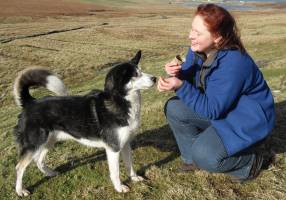 There is no quick fix, 'one-size-fits-all' recipe or waving of a magical wand and all problems seem to be solved with this type of behaviour therapy and training. There is also no endless repetition of exercises, dominance or control over your dog as this might produce some short-term results but will long-term only make matters worse.
There is no quick fix, 'one-size-fits-all' recipe or waving of a magical wand and all problems seem to be solved with this type of behaviour therapy and training. There is also no endless repetition of exercises, dominance or control over your dog as this might produce some short-term results but will long-term only make matters worse.
I expect empathy, commitment and an open mind from my future clients.
My goal will always be to try all I can to provide you with the tools to develop a truly rewarding relationship with your dog based on respect and trust, so that you can provide your dog with a life as near to perfect as possible.
For more information or to book an appointment, please phone 01595 890234 or 07900 201571
See also: Testimonials - Treatment Fees - Contact
